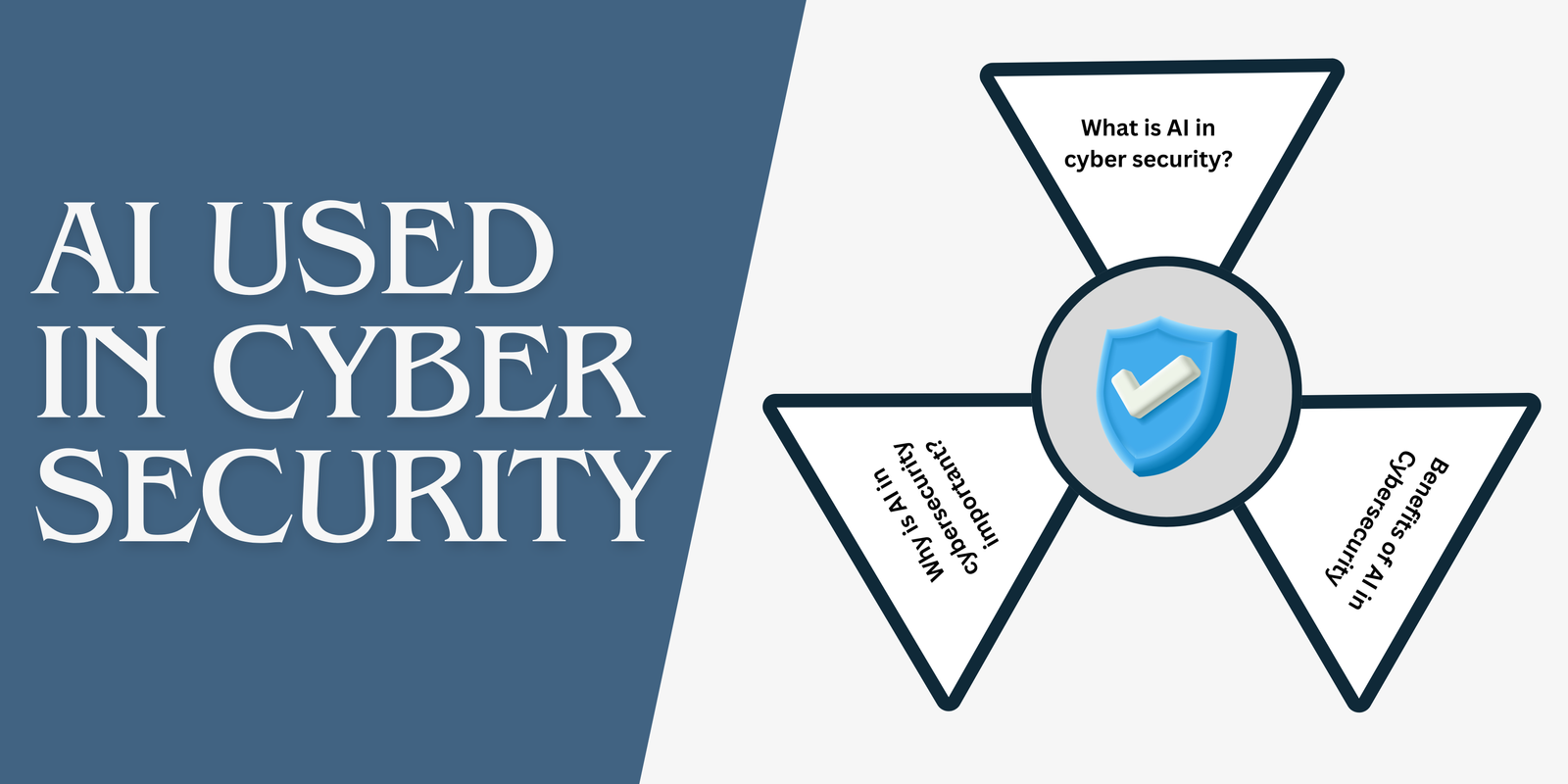How AI Used in Cyber Security Protects You from Cyber Threats

Cyber attacks have become more common in organizations today. According to the stats, the average number of cyber attacks per organization weekly was 1636 in the second quarter of 2024. The same study proves a 30 percent increase in cyber-attacks compared to the previous year.
Hence, it becomes more essential for businesses to take the necessary steps to fight against these attacks. As a business owner, you should leverage the latest technology to enhance cyber security in your organization. When it comes to the right technology for cyber security, Generative Artificial Intelligence (AI) has become a powerful technology that has transformed how organizations detect, manage, and respond to cyber-attacks and threats.
Are you interested in learning how this powerful technology boosts cyber security?
If yes, you should spend a few minutes with us to explore the power of AI in this field. Plus, we will discuss the top benefits that you may enjoy by leveraging it in your organization’s cyber security. On top of that, you will get valuable insight that will help you use this technology for cyber security.
What is AI in cyber security?
Artificial Intelligence (AI) in cyber security integrates AI technology like machine learning and neural networks into the security framework of a business. They let cyber security systems analyze a vast amount of data and understand patterns. These technologies allow your cyber security system to adapt to new and evolving risks with the least human intervention. AI-powered cyber security is also able to scan the entire network for weaknesses to prevent common cyber attacks, as it can analyze a wide amount of data to detect indicative patterns of a cyber threat.
Artificial intelligence monitors and analyzes behavior patterns. It can detect unusual behavior and prevent unauthorized access to the system using these patterns to create a baseline. This technology can also prioritize risk by instantly detecting chances of malware and intrusion before they start developing within a system.
Why is AI in cyber security important?
You might be shocked to know that cybercriminal businesses have already invested in Artificial intelligence, ML, and other similar technologies to launch large-scale and targeted cyber attacks against companies. Therefore, the number of threats and potential for ransomware impacting networks is expected to grow.
Do you know the best part?
Artificial Intelligence and ML are helping security analysts like you to level the playing field by processing massive amounts of data and giving rapid insight based on analysis. On top of that, they can cut through the noise of daily security alerts and false positives. It drastically improves your team’s productivity and efficiency and gives them benefits over traditional cybercriminals. Cybercriminals can easily bypass traditional and file-scanning-based antivirus protection due to the rise of sophisticated attack vendors like scripting, polymorphic malware, and more. Therefore, more modern protection approaches like behavior analysis have become famous for securing against this malware. Behavior analysis is a powerful approach because all malware eventually needs to exhibit its behavior to succeed. With proper training, Artificial intelligence can monitor, detect, and respond to these malicious behaviors faster than humans.
Read More: Cyber Security Why Is It Important
Benefits of AI in Cyber security
Apart from keeping your organization secure, AI can provide you with countless benefits. Let us explore the top benefits of using artificial intelligence in cyber security:
- Detect cyber threats faster
As mentioned above, Artificial Intelligence is capable of detecting cyber threats faster than humans within your organization. Countless security solutions log thousands and thousands of events that indicate anomalous behaviors. While most of these events are harmless, some may be dangerous. The consequences of overlooking a possible cyber threat can also be severe. AI helps identify the incidents that matter. You can use this technology to detect behaviors that may not look harmful but indicate a potential cyber threat when combined with other activities.
- Better vulnerability management
You can also use this technology for better vulnerability management within your organization. It is among the significant benefits of this technology. Ai-powered vulnerability scanners may prioritize risk based on exploitability, business criticality, and reachability. It helps you address the most pressing issues initially. These scanners decrease false positivity and make sure your security team members are working effectively. This technology also detects potential risks as unknown devices, cloud applications, and more.
- Protect data
AI tools can identify shadow data and monitor for abnormalities in access data. It can also send you alerts about potential threats by malicious actors accessing the data or sensitive information within your system. You can save valuable time in detecting and remitting issues in real-time with these tools.
- Breach risk
While accounting for IT asset inventory, security, along with threat exposure control effectiveness, AI-based systems have the ability to predict how and where you have the most chances of being breached. It can help you plan for resources and tool allocation toward areas of weakness. This analyst can help you configure and boost control to improve your business’s cyber security more effectively.
- Automated recommendation
The clarity of recommendation and analysis is another key advantage of using AI to empower the human security team. It is essential to get buy-in from stakeholders across the business. It is also helpful in understanding the impact of many security programs and reporting relevant to stakeholders, like security operations, end users, CEOs, and more.
uses of AI
Artificial Intelligence can be used in several methods for cyber security. Let us look at the top use cases for using this technology in terms of AI:
- Anomaly detection
Anomaly detection is among the best fits for the pattern recognition power of ML and AI. It is the process of the determination of rare or strange patterns in the log, traffic, and other data. Whether it’s network traffic, user activity, or other data, artificial intelligence is ideal for spotting potential harmful elements with proper training and algorithms. It can occur in several ways. This method begins with preset norms for a system like network traffic, log, and API calls. It can employ statistical analysis to monitor system behavior and action continuously to trigger an action when an anomalous or rare action is discovered.
Apart from spotting patterns, it can also categorize and group them to assign priority levels. Assigning priorities to several events is essential because it helps avoid “alert fatigue.” This situation can occur when users or security is overwhelmed by too many alerts. Some of these alerts often may not be very significant. By prioritizing alerts, you may focus on the ones that matter the most and decrease the worry from less essential alerts.
- Threat management
Once the anomaly or threat has been detected, artificial intelligence is also a key to the threat management process. It can prioritize vulnerabilities based on their potential impact. It allows you to address critical issues first and streamline patch management. This process involves prioritizing threats based on risk levels and determining the most appropriate response. AI can help you mastermind responses in real time that decrease the damage caused by the attack.
- Breach risk prediction
If you have a significant organization, you might know that you have a significant IT inventory that makes it difficult to access every possibility of a security breach. AI algorithms can predict the types of attacks and identify the component most vulnerable to breach. Researchers have already produced a model based on cognitive learning to follow the authorized logins at security access points. This model can catch remote breaches early to prevent a potential data breach, notify users, and add extra layers of protection. You can allocate resources and technologies more effectively to develop significant cyber resilience and prepare for upcoming assaults by obtaining early signs of breaches and hacks.
- Security log analysis
AI has revolutionized log analysis with a machine-learning algorithm to analyze large amounts of real-time log data. As discussed above, this technology empowers you to identify and respond to potential security breaches instantly by detecting patterns and anomalies. On top of that, it can detect potential insider threats via deep analysis of your user activities across many systems and applications.
- Endpoint security
Endpoint security has turned into the most essential element to maintain robust cyber security. AI-driven endpoint protection adopts a dynamic approach by establishing a baseline of normal endpoint behavior and detecting a deviation in real time. It can identify potential threats by continuously learning from network behavior. With the help of this technology, you can boost password protection and user account security with advanced security techniques. CAPTCHA, facial recognition, fingerprint scanners, and more are some examples of those methods that automatically detect genuine login attempts.
Conclusion
The number of cyber attacks is continuously increasing with time on organizations. Therefore, it can become crucial for businesses to adopt the right technology to fight against these attacks. Artificial intelligence (AI) has become a powerful tool that can protect your organization from any security attacks. You can utilize this technology in cyber security in several ways, like anomaly detection, threat management, and more. However, you need to integrate and train this technology perfectly to enjoy its benefits.




16 Comments